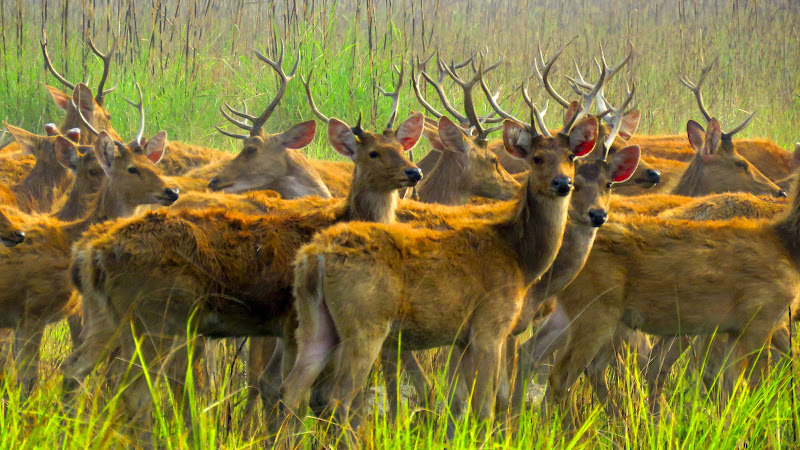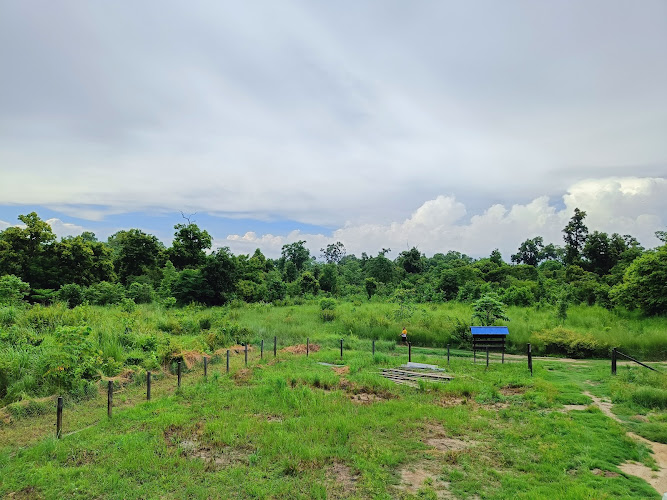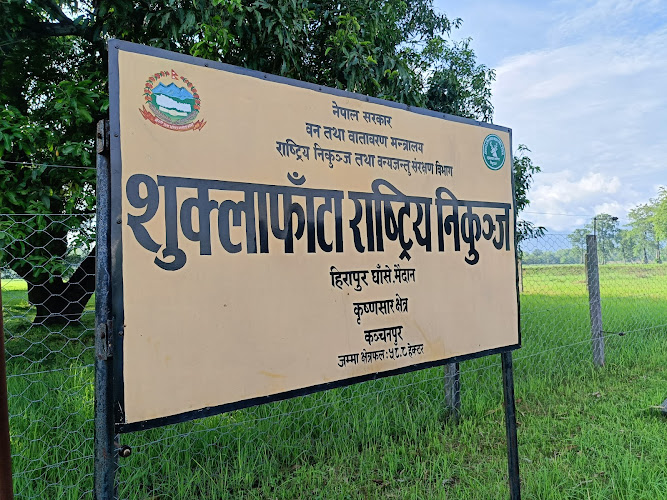



Shuklaphanta National PARK - Complete Visitor Guide
V743+5QF, NP, 10400
When grasslands stretch unbroken to the horizon and swamp deer congregate in herds numbering hundreds, you've arrived somewhere singular in South Asia. Shuklaphanta National Park, anchoring Nepal's southwestern corner just kilometers from the Indian border, protects 305 square kilometers of the Terai's most extensive grasslands—including Shuklaphanta itself, a 16-square-kilometer expanse of continuous phantom grass that constitutes Nepal's largest unbroken grassland patch and one of South Asia's most important. Upgraded from wildlife reserve to national park status in 2017, Shuklaphanta harbors the world's largest population of swamp deer, with 2,313 individuals counted in 2022 representing an extraordinary conservation success for a species that teetered toward extinction across its South Asian range.
The swamp deer, called barasingha for their distinctive multi-pointed antlers that can reach 12 points or more, define Shuklaphanta's identity. These large cervids adapted specifically to wetland and grassland habitats, their splayed hooves distributing weight to prevent sinking in muddy ground. During the dry season from November through March, herds congregate on the main Shuklaphanta grassland, creating wildlife spectacles rarely witnessed in modern Asia—hundreds of deer grazing together while chital spotted deer and hog deer mix among them, raptors circle overhead hunting for rodents, and the occasional tiger slinks through the tall grass stalking prey. The 2022 census marking growth from 2,280 individuals in 2021 proves that protection works when habitat remains intact and anti-poaching measures prove effective.
But Shuklaphanta's conservation significance extends beyond swamp deer. The park protects 46 mammal species including 15-20 Bengal tigers prowling the forests and grassland edges, one-horned rhinoceros reintroduced through translocations from Chitwan, wild elephants migrating across the porous border with India, and the endangered hispid hare surviving in tall grasslands where it excavates shallow forms rather than deep burrows. Bird diversity reaches 350 species including 180 breeding residents and numerous winter migrants from Central Asia and Siberia that descend upon Rani Tal and other wetlands each autumn. The endangered Bengal florican, swamp partridge, and sarus crane represent flagship wetland species drawing ornithologists and wildlife photographers.
Rani Tal, a lake within the park, carries historical significance beyond its wetland ecology. A brick wall measuring 1,500 meters in circumference surrounds the lake, remnants of a fort locals attribute to the Tharu king Singpal who ruled this region before Nepal's unification. The fortification hints at the Tharu people's deep roots in the Terai, their kingdoms flourishing in lowlands where malaria killed outsiders but where Tharu genetic adaptations allowed survival and prosperity. Today, Tharu communities inhabit buffer zones surrounding the park, maintaining cultural traditions while navigating modern conservation restrictions that limit access to resources their ancestors used freely.
Grassland management represents critical work at Shuklaphanta. Left unmanaged, grasslands succeed to scrub forest, eliminating the open habitat swamp deer require. Park rangers conduct controlled burns annually, removing dead vegetation and allowing fresh growth that provides nutritious forage while maintaining sightlines for wildlife viewing. Villagers harvest grass under permit systems during designated seasons, taking thatch for construction and fodder for livestock while simultaneously preventing the build-up of fuel loads that could feed catastrophic fires. This blending of conservation and traditional use demonstrates community forestry principles applied to grassland ecosystems.
The park's forests—sal mixed with khair, sisso, and jamun trees—provide cover for tigers, leopards, and sloth bears while supporting different bird communities than grasslands. Forest edges create ecotones where biodiversity peaks as species from both habitats overlap. Riverine forests along seasonal watercourses harbor even more specialized plants and animals adapted to periodic flooding and dry-season drought. This habitat mosaic explains Shuklaphanta's exceptional species diversity compressed into modest area.
Visitor infrastructure remains deliberately low-key. The park headquarters near Majgaon provides basic facilities and information, while a scattering of watchtowers allows elevated viewing across grasslands. Jeep safaris operate during dry months from October through May when grass height permits visibility and animals concentrate around remaining water sources. Walking safaris, guided by armed rangers, offer more intimate encounters though they require early morning starts to maximize wildlife activity before midday heat reduces animal movement.
Reaching Shuklaphanta demands commitment. From Kathmandu, the journey spans 12-14 hours by road to Mahendranagar, the nearest city, or a 90-minute flight to Dhangadhi followed by a three-hour drive. This remoteness deters mass tourism, keeping annual visitor numbers below 5,000 and preserving the wilderness character that makes Shuklaphanta special. Accommodations range from basic park lodges to slightly more comfortable hotels in Mahendranagar, though luxury options remain absent—a situation most serious wildlife enthusiasts consider a feature rather than a bug.
Conservation threats include habitat encroachment as agricultural expansion eats into buffer zones, human-wildlife conflict when tigers prey on livestock or elephants raid crops, and cross-border challenges requiring coordination with Indian authorities for species that migrate regardless of political boundaries. Yet Shuklaphanta's swamp deer numbers prove that dedicated conservation can reverse even dire population declines. These grasslands that once stretched unbroken across the Terai now exist only as fragments, making every protected hectare precious and every successful breeding season cause for celebration.
Park Features & Amenities
♿ Accessibility
- ✓ Wheelchair-accessible car park
- ✓ Wheelchair-accessible entrance
🏃 Activities
- ✓ Hiking
🏗️ Amenities
- ✓ Barbecue grill
- ✓ Picnic tables
- ✓ Public toilet
- ✓ Swings
🎠 Children
- ✓ Good for kids
- ✓ Good for kids birthday
- ✓ Kid-friendly hikes
- ✓ Playground
🐕 Pets
- ✓ Dog park
Visitor Information
🕐 Best Times to Visit
Spring (Mar-May): Pleasant weather, blooming flowers
Autumn (Sep-Nov): Clear skies, comfortable temperatures
Early Morning: Best for wildlife viewing and photography
🗺️ Getting There
By Car: V743+5QF, NP, 10400
Public Transport: Local buses and taxis available
Walking: Check distance from city center
💡 Visitor Tips
• Bring water and sun protection
• Wear comfortable walking shoes
• Check weather conditions before visiting
• Bring camera for nature photography
Explore More in Nepal
Ready to Visit Shuklaphanta National PARK?
Plan your visit to this amazing destination with our comprehensive travel guide and insider tips.
Seasonal Travel Guide
Weather & Best Time
Autumn offers the best weather (15-25°C) with clear skies, excellent mountain views, and comfortable temperatures for all activities.
Best Activities:
- Mountain trekking
- Wildlife safaris
- Cultural tours
- Photography expeditions
- Adventure sports
Travel Tips
- Visit during September-November for optimal conditions
- Book early as autumn is the most popular season
- Plan for clear mountain views and excellent trekking
- Enjoy cultural festivals and celebrations
Packing Suggestions:
- Warm layers for cool evenings
- Sturdy hiking boots
- High-quality camera
- Sunglasses and sunscreen
- Comfortable daypack
Quick Facts
Best time: Autumn (Sep-Nov)
Duration: 1-3 days
Difficulty: Easy
Cost: Budget-friendly